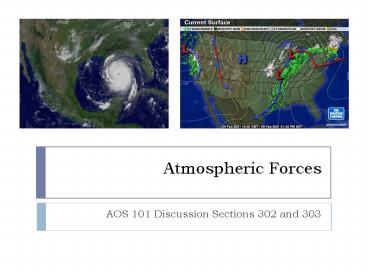Atmospheric Forces - PowerPoint PPT Presentation
1 / 42
Title:
Atmospheric Forces
Description:
Pressure Gradient Force PGF and Wind Isobars and PGF PGF PowerPoint Presentation Coriolis Force PowerPoint Presentation PowerPoint Presentation PowerPoint ... – PowerPoint PPT presentation
Number of Views:240
Avg rating:3.0/5.0
Title: Atmospheric Forces
1
Atmospheric Forces
- AOS 101 Discussion Sections 302 and 303
2
Why Does the Wind Blow?
- What makes the wind blow?
- We need to think about Newton's Laws
- 1st Law
- An object at rest will remain at rest an object
in motion will remain in motion as long as no
force is exerted on the object. - 2nd Law
- The total force exerted on an object is equal to
the acceleration of the object times its mass
3
Pressure Gradient Force
- Compels fluids to move from high pressure to
lower pressure
4
PGF and Wind
5
Isobars and PGF
6
PGF
7
(No Transcript)
8
Coriolis Force
- An apparent force
- Results from the constant rotation of the Earth
- Northern Hemisphere
- Acts at a 90angle to the right of the object in
motion (such as the wind) - This means that a wind from the south would have
a CF acting toward the east
9
Imagine Dallas, TX fires a missile at Winnipeg,
Manitoba
10
Missile starts at Dallas, which is at a latitude
of 37.28 N, rotates with the Earth at a speed of
465.11 m/s.
11
Missile travels toward Winnipeg which, at a
latitude of 52.00 N, rotates with the Earth at a
speed of 286.35 m/s
12
(No Transcript)
13
(No Transcript)
14
(No Transcript)
15
Geostrophic Balance
X
16
Geostrophic Balance
17
Geostrophic Balance
18
Geostrophic Balance
19
Upper Level Flow
20
Geopotential Height
21
Geopotential Height
22
PGF/ CF/ Centripetal
23
(No Transcript)
24
Friction Force
Friction
Wind
25
Friction Force
- This throws the wind out of geostrophic balance
- There is now a net force acting on the wind in
the direction opposite its motion
PGF
Wind
FR
CF
26
Friction Force
- Upper Level Wind
- Balance PGF/ CF
- Lower Level Wind
- Balance PGF/ CF/ Friction
- Friction causes wind to cross isobars at
30angle at surface
27
(No Transcript)
28
Front Collapse Experiment
29
Front Collapse Experiment
30
Rotating Tank Experiment
31
Atmospheric Fronts
- AOS 101 Discussion Sections 302 and 303
32
Warm Front
33
Warm Front
- Drawn as a red line with red semi-circles
pointing in the direction of the fronts movement
34
Cold Front
- Drawn as a blue line with blue triangles pointing
in the direction of the fronts movement
35
Stationary Front
- Stalled
- No movement of the temperature gradient
- Convergence of wind
- Drawn as alternating segments of red semicircles
(warm front) and blue triangles (cold front) in
opposite directions
36
Occluded Front
- A region where a faster moving cold front has
caught up to a slower moving warm front. - Generally occurs near the end of the life of a
cyclone - Drawn with a purple line with alternating
semicircles and triangles
37
Cold Occlusion
- The type most associated with mid-latitude
cyclones - Cold front "lifts" the warm front up and over the
very cold air - Associated weather is similar to a warm front as
the occluded front approaches - Once the front has passed, the associated weather
is similar to a cold front - Vertical structure is often difficult to observe
38
Warm Occlusion
- Cold air behind cold front is not dense enough to
lift cold air ahead of warm front - Cold front rides up and over the warm front
- Upper-level cold front reached station before
surface warm occlusion
39
Fronts
40
Identifying Fronts
- We know that we need to look for low pressure and
a boundary of cold and warm air. - To pinpoint the parts of our cyclone, look for
specifics in the observation maps - Find the center of cyclonic rotation
- Find the large temperature gradients
- Identify regions of wind shifts
- Identify the type of temperature advection
- Look for kinks in the isobars
41
(No Transcript)
42
(No Transcript)































